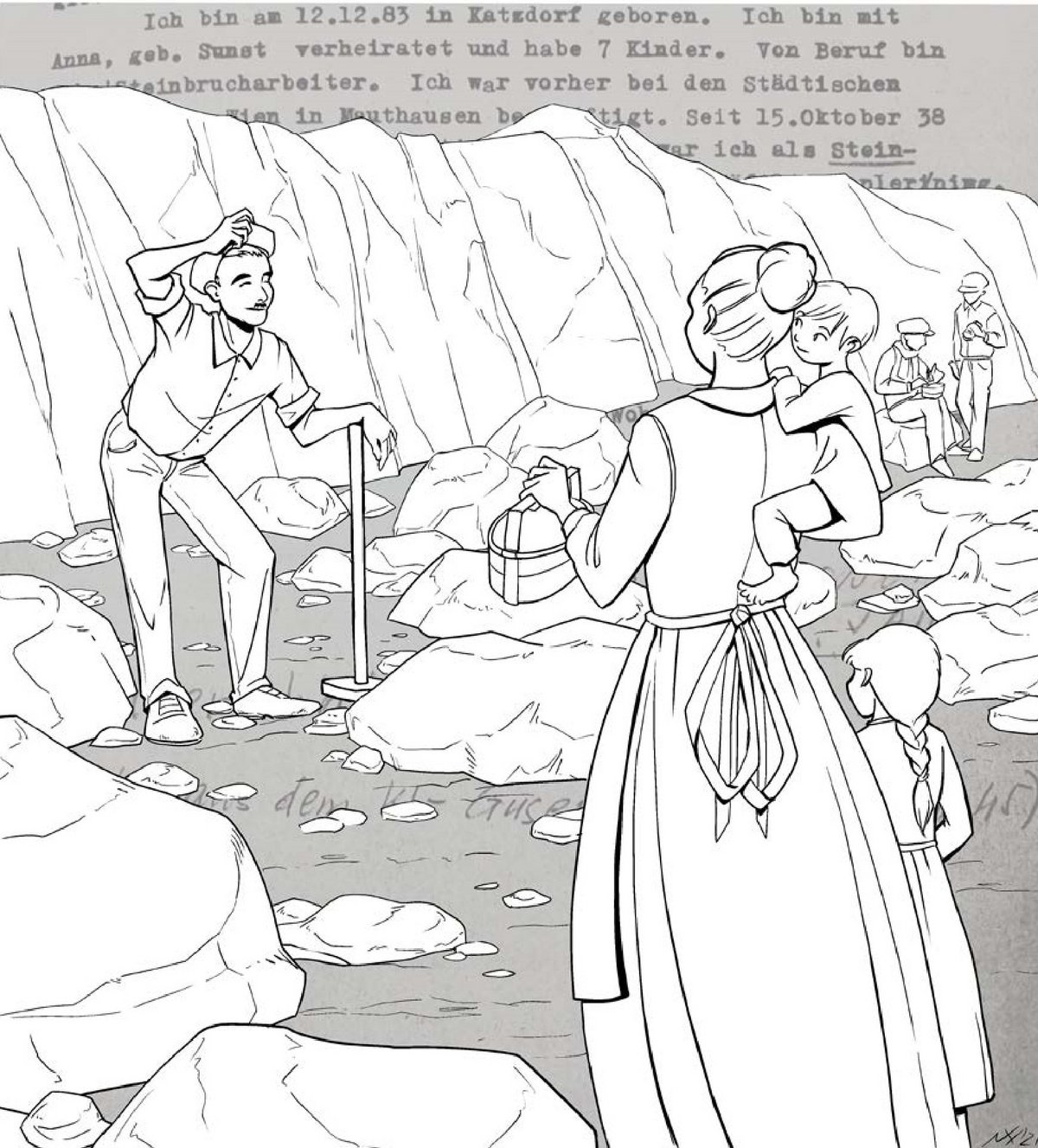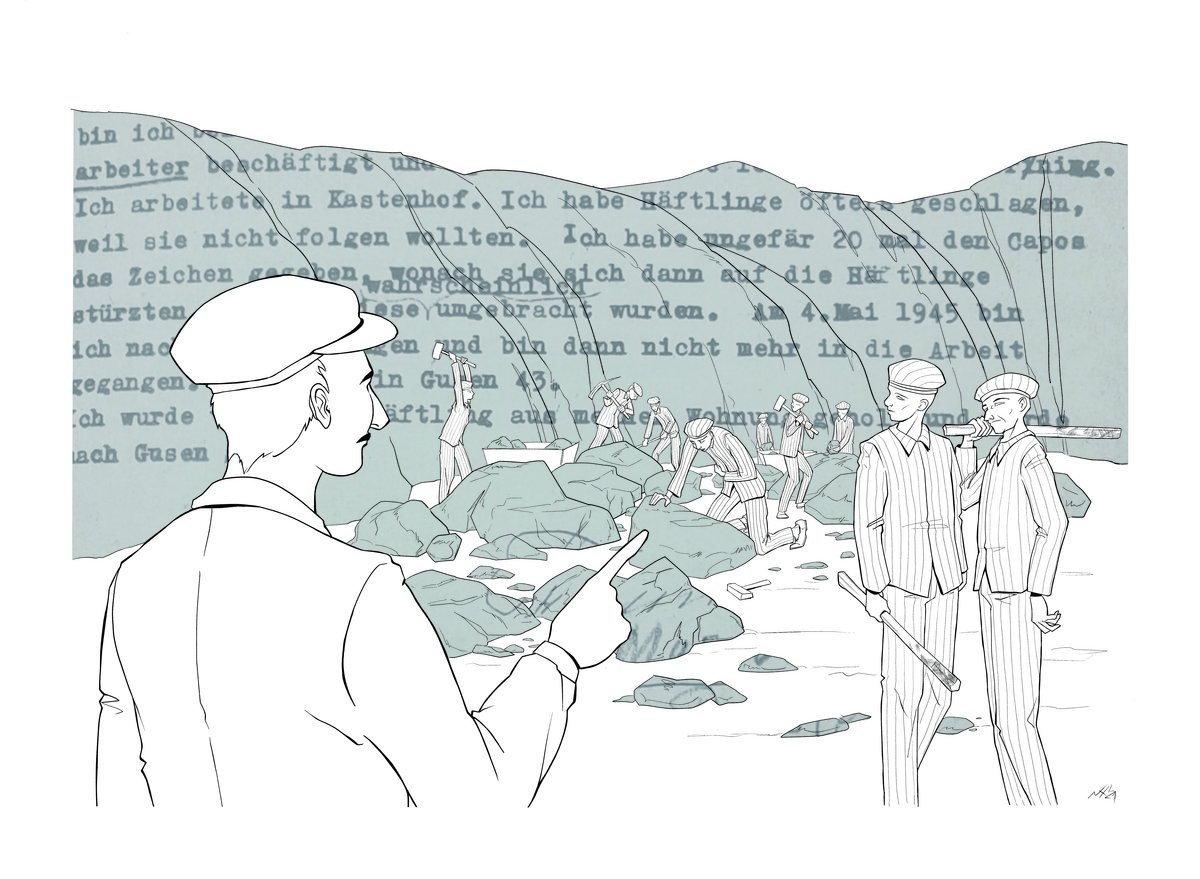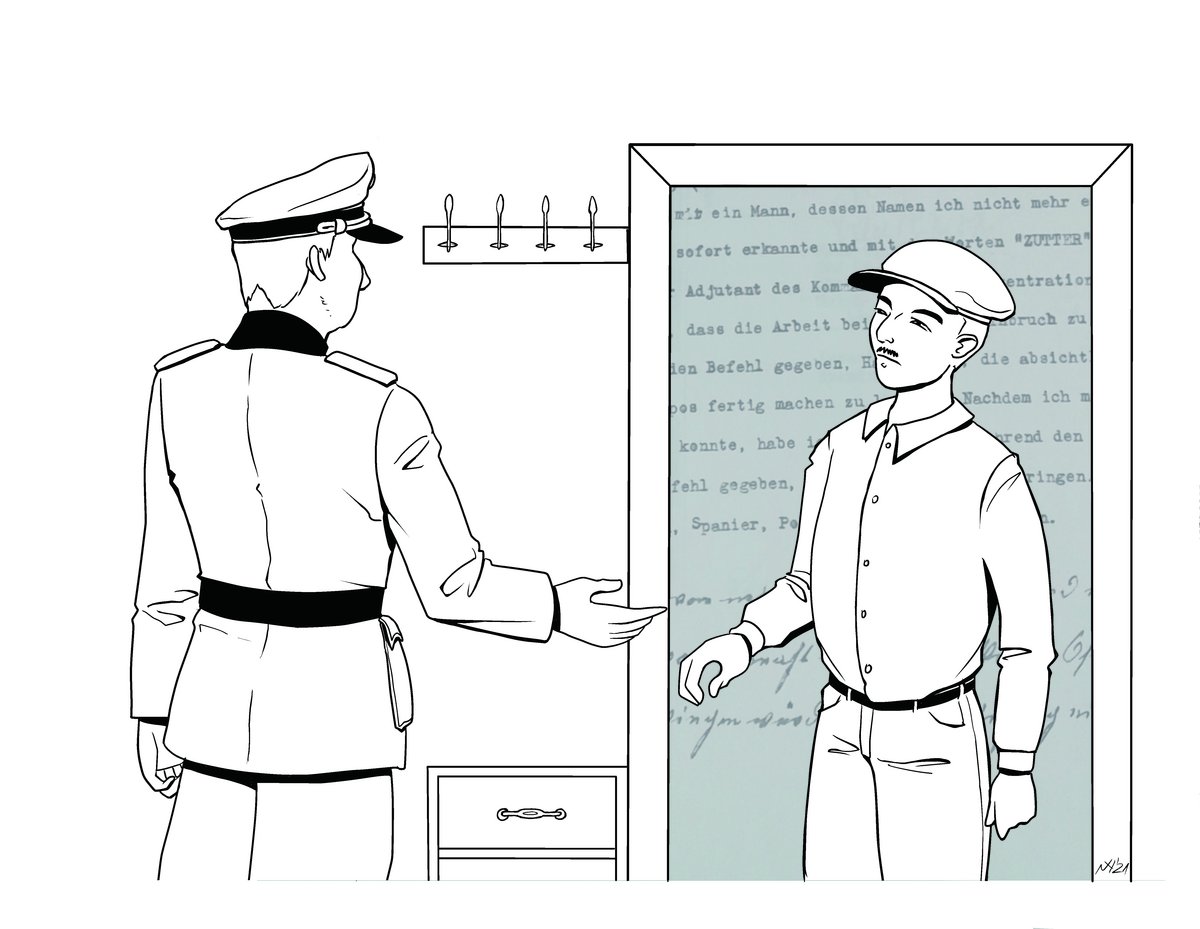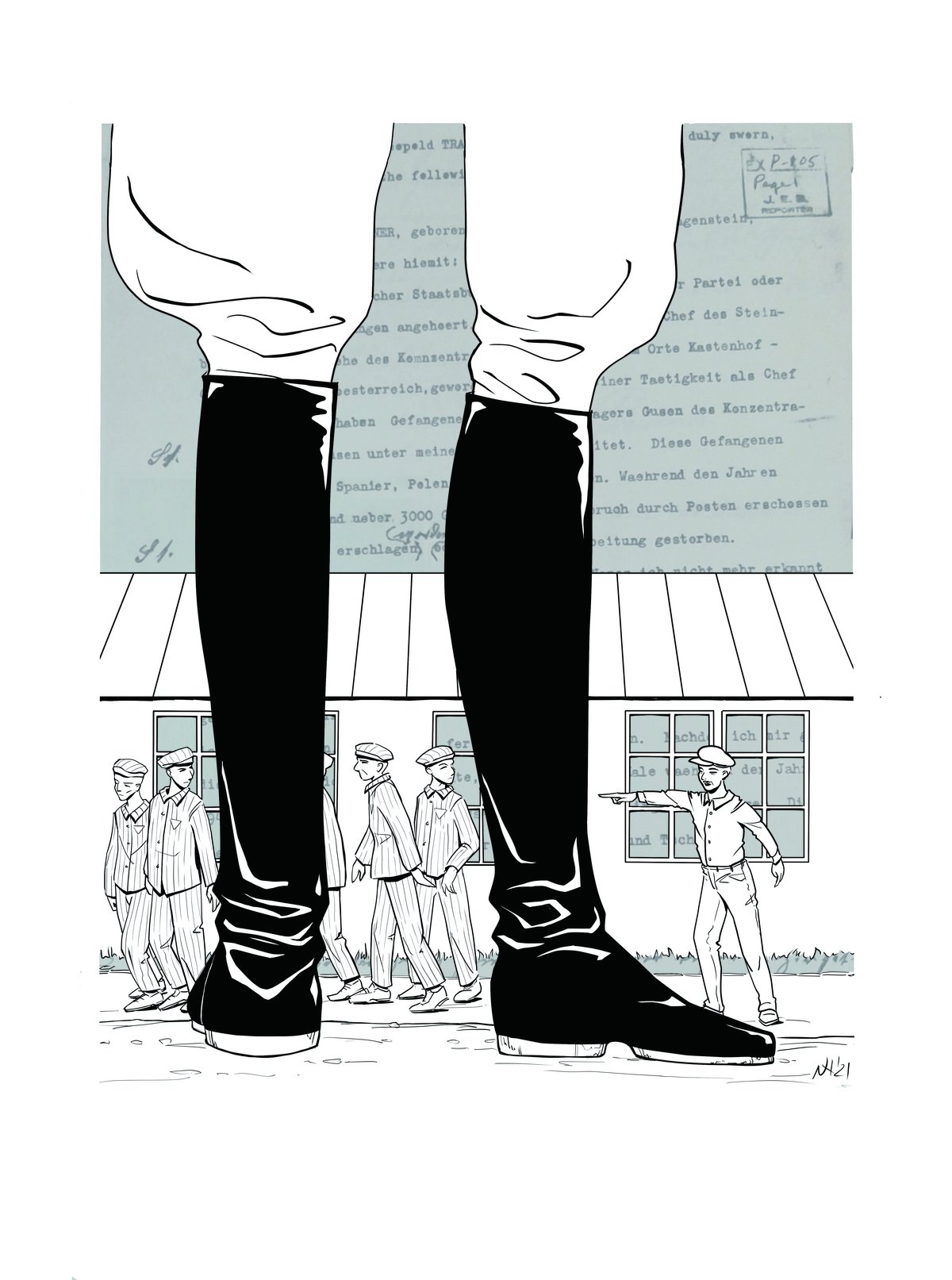In 1938, in a small town in Upper Austria, one of the many Nazi concentration camps was constructed. It was known as the Mauthausen concentration camp. It existed from 1938 to 1945. The camp was run and guarded by the SS. The people who were imprisoned here came from many countries in Europe: Poland, Russia, France, Italy, Germany, Austria and others. They were political opponents, belonged to marginalised groups (e.g. ‘criminals’, ‘asocials’) or were persecuted for anti-Semitic and racist reasons (e.g. Jews). Most of the prisoners were men, but there were also women and children.
In the Mauthausen quarry, the prisoners carried out hard forced labour. In the more than 40 subcamps (Gusen, Steyr, Linz, Ebensee, Vienna...), they were deployed in the arms industry. People lived in overcrowded accommodation. They were not given enough food and clothing, and they starved and died of diseases. SS men beat many prisoners to death, shot them or murdered them in the gas chamber at Mauthausen. In total, almost 200,000 people were imprisoned at Mauthausen and its subcamps. Half of them lost their lives.
The Mauthausen concentration camp was on a hill and could be seen for miles around. Many people were involved with the camp: they worked there, brought deliveries or knew SS men. Almost everyone knew about the death camp. Often, the SS men committed the crimes in full view of the population. On 5 May 1945, the Mauthausen concentration camp was liberated by US troops.
Here, you will read the story of a person who was connected with the Mauthausen concentration camp.
Leopold Trauner
Text: Stefan Vass – Illustration: Nina Hable

Leopold Trauner is born in 1883 in Katsdorf in the Mühlviertel region of Upper Austria.
Trauner marries and has seven children with his wife Anna. The family lives in Gusen, where he works as a labourer in quarries.
In August 1938, a few months after the ‘Anschluss’ (‘Annexation’) of Austria to Nazi Germany, the Mauthausen concentration camp is established. Mauthausen is chosen as the location because of the area’s many granite quarries. There are plans to carry out major construction projects in the German Reich. Granite is needed to build the planned buildings, roads and power plants. An SS company, Deutsche Erd- und Steinwerke (DEST), runs the quarries in the Mauthausen and Gusen concentration camps. Most of the concentration camp prisoners have to do hard forced labour in the quarries for the company. From 1943, the prisoners are increasingly deployed in arms production, as the German Reich attempts to win the Second World War by all possible means.

SS men and ‘Kapos’ guard the concentration camp prisoners in the quarries. But their work is managed by civilian workers from the local area. One of them is Leopold Trauner. He is about 55 years old when he becomes an employee of the SS company Deutsche Erd- und Steinwerke.
The civilian workers perform various tasks in the quarries. Some oversee the concentration camp prisoners, some act as quarry foremen and are in charge of the work, and others are drivers. Many people from the surrounding area also work in the offices of Deutsche Erd- und Steinwerke in St. Georgen an der Gusen. Family members of SS men are also employed at the offices.
For example, the wife of the Gusen camp commander, Karl Chmielewski, works there as an accountant. There is a large apprentice programme for local youths: the young men can learn to become locksmiths and stonemasons in the workshops of the concentration camps.
According to his own account, Leopold Trauner first works as a stone worker in the Gusen concentration camp, and later becomes head of the Kastenhof quarry. He holds this position until the quarry closes. After that, his account states that he works as a driver.
Trauner lives with his family in Gusen in one of the flats provided to the staff of the Deutsche Erd- und Steinwerke. On 4 May 1945, he goes home after finishing his work for the day at the concentration camp. He does not return the next day – on 5 May, the Gusen concentration camp is liberated by the US Army.

In June 1945, Trauner is captured by former concentration camp inmates and taken to the former camp at Gusen, where the Americans open an investigation into his actions. As a supervisor at the quarry, Trauner is accused of mistreating many concentration camp prisoners. When questioned, Trauner says that more than 3,000 concentration camp prisoners were shot or beaten to death by Kapos while he worked in the quarry from 1939 to 1945. Regarding his own actions, he gives the following testimony when questioned by the Americans: ‘In 1942, a man [...] who was the adjutant of the commander of the Mauthausen concentration camp told me that the work at our quarry was going too slowly. He also gave me orders to have Kapos kill prisoners who deliberately worked slowly. After I was unable to do anything to resist this order, I gave Kapos the order to kill these prisoners on several occasions between 1942 and 1945.’
Leopold Trauner has met the expectations of the SS. When questioned, he admits: ‘I would often beat inmates because they wouldn’t follow orders. I gave the signal to the Kapos about 20 times, after which they set upon the prisoners, who were probably killed.’
He is sent to several internment camps where former Nazis are held, including Gmunden and Glasenbach near Salzburg. Eventually, Trauner is taken to Dachau near Munich, where there was a large Nazi concentration camp. At the camp, the US Army brings the defendants accused of crimes committed at the Mauthausen concentration camp before a military tribunal.

Most of the defendants are SS members. Leopold Trauner was not a member of the SS, but he also has to stand trial at the court from March 1946. Several witnesses report that he beat concentration camp prisoners in the quarry and ordered the Kapos to attack the inmates. Trauner himself recants his earlier statements in court. He now claims that he did not order the Kapos to mistreat the prisoners who worked too slowly.
In May 1946, the US military tribunal in Dachau sentences Leopold Trauner to death. One year later he is executed in Landsberg am Lech.
Most of the civilian workers of the SS company Deutsche Erd- und Steinwerke never stand trial.
- 1883 Leopold Trauner is born in Katsdorf
- 1914 28 July, start of the First World War
- 1918 11 November, end of the First World War
- 1920er He marries and moves to Gusen, where he works in the quarries
- 1933 30 January, Adolf Hitler becomes Reich Chancellor in Germany
- 1938 12 March, ‘Anschluss’ (‘Annexation’) of Austria to Nazi Germany
- NS-Zeit He is an employee of the SS company "DEST"
- 1939 1 September, start of the Second World War
- December, Construction begins on the Gusen concentration camp
- 1945 5 May, Mauthausen concentration camp is liberated by the US Army
- 8 May, Nazi Germany surrenders; end of the Second World War in Europe
- Trauner is arrested by former SS-Members
- 1946 He is tried in court and sentenced to death
- 1947 The death sentence is carried out in Landsberg am Lech
Further reflection in groups...
Leopold Trauner becomes a civilian worker for the SS company Deutsche Erd- und Steinwerke. Why does he take this job?
Many civilians work in the quarries of the Mauthausen and Gusen concentration camps. What do they see there?
Look at the drawings and reflect on what they say about the power relations in the concentration camp.
During the tour of the Memorial, you will learn about how the population perceived the events in and around the camps. How do you think the prisoners viewed the behaviour of the population?